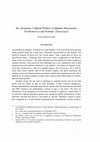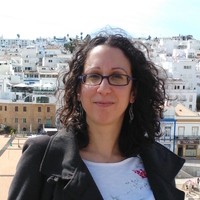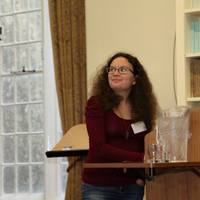Papers by Fotini Hadjittofi

Quintus Smyrnaeus: Transforming Homer in Second Sophistic Epic (De Gruyter), 2007
This chapter juxtaposes Quintus’ Posthomerica and Nonnus’ Dionysiaca in terms of the political an... more This chapter juxtaposes Quintus’ Posthomerica and Nonnus’ Dionysiaca in terms of the political and ideological positions they adopt towards Rome, and argues that the way they represent Hellenic and Roman identities is characteristic of the different cultural environments in which they were written. The first section is concerned with the characterisation of Aeneas and Sinon in Books 11-13 of the Posthomerica; Quintus’ depiction of these two characters reflects a contestation and re-negotiation between Roman and Greek identities, which is typical of the Second Sophistic period. The following section contrasts the treatment of the Pleiad Electra and the myths relevant to her in the two epics, in order to elucidate the differences between Quintus’ and Nonnus’ attitudes towards the Roman Empire. Finally, the third part of the paper turns to the question of Nonnus’ embrace of Rome and Roman ideology, and briefly examines the phenomenon of the collapse of traditional Hellenism in Late Antiquity, as it is expressed in Book 41 of the poem, the story of Beirut.
Materiali e discussioni per l'analisi dei testi classici, 2008
The Literary Encyclopedia
Unclassical Traditions II. Cambridge University Press, 2011
Vir bonus peritissimus aeque. Estudos de homenagem a Arnaldo do Espirito Santo, 2013
The Ancient Novel and the Frontiers of Genre, 2014
The extensive episode of Morrheus and Chalcomede, which covers books 33-35 of Nonnus’ fifth centu... more The extensive episode of Morrheus and Chalcomede, which covers books 33-35 of Nonnus’ fifth century epic, the Dionysiaca, has almost all the ‘ingredients’ of a novel. This paper emphasises the way Nonnus re-formulates, adapts, and subverts novelistic themes throughout this episode, thus showing the gap between contemporary sexual ethics, where perpetual female virginity is glorified, and the ideology of marriage which drives the plots of the earlier erotic novels. The empowerment and masculinisation of the devoted virgin, Chalcomede, and the corresponding powerlessness and feminisation of the male hero, Morrheus find parallels (and, in the final scene, perhaps also inspiration) in Christian texts.
New Perspectives on Late Antiquity in the Eastern Roman Empire, 2014

Brill's Companion to Nonnus of Panopolis, 2016
A feature which will immediately strike the first-time reader of Nonnus' Dionysiaca is the poet's... more A feature which will immediately strike the first-time reader of Nonnus' Dionysiaca is the poet's penchant for creating formulaic scenes or expressions: verses can be repeated verbatim or in a slightly varied form, and passages can be recast several times, with different protagonists and only minor alterations.1 These recurrent scenes and expressions are certainly a manifestation of Nonnus' aesthetic principle of ποικιλία (variatio),2 and have an obvious role to play in structuring the poem. For example, in looking for unifying threads that would tie together the disparate episodes of the Dionysiaca, scholars have identified a set of close structural parallels between the first and last books of the epic.3 Thus, the narrative proper begins with a rape (of Europa, by Zeus) and ends with a rape (of Aura, by Dionysus). The Typhonomachy, in which Zeus defeats Typhoeus, in Books 1-2 corresponds to the Gigantomachy, in which Dionysus defeats the Giants of Thrace, in Book 48. The tragic narratives of Actaeon (Book 5) and Pentheus (Books 44-46) clearly echo each other. Even though this chapter will often focus on the thematic correspondences between the first and last books (as themes which appear in these narratively privileged positions are likely to be fundamental for the whole poem), it does not aim to explore structural questions, such as how far we can push these particular similarities and to what extent Nonnus was indeed striving for a perfect ring composition.4 My aim is to provide an outline of the most important themes and motifs which recur throughout the entire epic, and which will be studied

Fabrique de la déclamation, 2016
Cross-dressing is a major theme in two of Choricius’ declamations: the Lydians (Declamation 3) an... more Cross-dressing is a major theme in two of Choricius’ declamations: the Lydians (Declamation 3) and the War-Hero (Declamation 11). In both declamations dress is considered, by the speakers themselves, a significant marker of gender identity, so that putting on feminine clothes seriously jeopardises the cross-dresser’s masculine status – a line of reasoning that sees gender as socially constructed. The opposite argument, however, is latent in both speeches. This paper argues that Choricius (and in this he is not alone among Greek Late Antique orators) promulgates an essentialist view of gender, which dismisses dress and physical appearance as reliable indicators for the condition of the inner self. While for many Christian thinkers the condition (or appearance) of the body reveals and/or influences the condition of the soul, there are “essentialist” trends not only in their own thinking, but also (and more strikingly) in popular stories about saints and martyrs, some of which even involve transvestism. It is also relevant for the dissociation between the (effeminate) appearance and the (masculine) reality of Choricius’ transvestites that there emerges in Late Antiquity a sense of privacy, which allows an individual to lead an entirely secret life, which could contrast with his/her public image.
L’École de Gaza, Peeters, 2017
Vigiliae Christianae, 2018
This article examines three passages in Nonnus' Paraphrase of the Gospel according to John (19.21... more This article examines three passages in Nonnus' Paraphrase of the Gospel according to John (19.21-25; 19.118-132; 20.81-82), all of which mention pieces of clothing in the context of Christ's passion and resurrection. It argues that Nonnus allows, and indeed encourages, both literal readings and metaphorical interpretations of the garments as stand-ins for Christ's body. The readings which do not turn garments into symbols of the body would be more in agreement with the Orthodox theology of Nonnus' time, while the metaphorical interpretations would be more amenable to a heterodox (Origenist or Nestorian) construal. The poem's ambivalence in the employment of clothing metaphors indicates an attitude that is less strictly Alexandrian / Orthodox and more polyphonic than has so far been assumed.
American Journal of Philology, 2018
This article proposes a sustained politicized reading of the myth of Midas in Ovid's Metamorphose... more This article proposes a sustained politicized reading of the myth of Midas in Ovid's Metamorphoses. It argues that Midas stands, first, as the embodiment of failed, Hellenistic kingship, with its ostentatious display of wealth and heralding of a new Golden Age, and, second, as a warning against the infectious " love of gold " , to which Roman politicians are far from immune. While the capture of Silenus and the golden touch episode link Midas with the tropes of Hellenistic kingship, his involvement in the competition between Pan and Apollo raises questions about the tropes of Roman imperial power itself.
Learning Cities in Late Antiquity. The Local Dimension of Education (Routledge), 2019
This chapter looks at how Choricius represents and ‘constructs’ his native city, Gaza, as an idea... more This chapter looks at how Choricius represents and ‘constructs’ his native city, Gaza, as an ideal intellectual space: a privileged city of learning, a peaceful and calm environment in which ideas can be exchanged, and where town and gown not only coexist harmoniously side by side but are also mutually supportive. In his encomiastic orations Choricius places a strong emphasis on the Gazan officials’ skills in the non-violent resolution of conflicts, while in Declamation 12 the orator-hero (an idealised version of Choricius himself) appears as the guarantor of the city’s well-being and prestige.
Classical Quarterly, 2019
Cambridge Classical Journal, 2020

Harvard Theological Review, 2020
Lamentations Rabbah Proem 24, a late ancient rabbinic midrash, is in many ways a unique text with... more Lamentations Rabbah Proem 24, a late ancient rabbinic midrash, is in many ways a unique text within the entire rabbinic corpus. It presents an extraordinary array of characters (including Abraham, Moses, the Torah, and even the alphabet) who are called upon to placate God, but fail. As their quest proves inconclusive, the biblical Rachel jumps into the fray to tell her story: how out of sisterly compassion she allowed Leah to take her own place in the conjugal bed on "her" wedding night. Disclosing to her sister the secretive "signs" she had shared with Jacob, Rachel crawled under the nuptial bed to respond to Jacob whenever he spoke. This scandalous autobiography transforms an apparent instance of illicit sex, the ideal material for theatrical stage mimes, into an act of martyrdom and sublime compassion. This article argues that the performance culture of the late ancient Mediterranean world provides the key for assessing this text's originality. We begin with an analysis of the text, drawing attention to its theatrical qualities and its relationships with contemporary visual imagery (mosaics) and texts from outside the rabbinic milieu (Christian Apocrypha). We then examine the casting of midrashic Rachel as a response to both the mimic adulteress and the Christian martyr. Finally, we consider rabbinic familiarity with mime, particularly with its * Fotini Hadjittofi gratefully acknowledges the financial support of FCT (Fundação para a Ciência e a Tecnologia), Portugal, through the project PTDC/LLT LES/30930/2017 (national funds). 1 All references in this study hark back to the 1899 edition of Shlomo Buber, Midrasch Echa Rabbati (Vilna: Rom). There is certainly room for a new edition of Lamentations Rabbah and a comprehensive commentary. Paul D.
The Genres of Late Antique Christian Poetry. Between Modulations and Transpositions (De Gruyter), 2020
https://www.degruyter.com/view/book/9783110696219/10.1515/9783110696219-001.xml

The Genres of Late Antique Christian Poetry. Between Modulations and Transpositions (De Gruyter), 2020
Didactic is an ill-defined and much-maligned poetic genre. 1 While modern scholars struggle to st... more Didactic is an ill-defined and much-maligned poetic genre. 1 While modern scholars struggle to stipulate the criteria by which a poem can be termed 'didactic', 2 ancient grammarians generally did not even set such a (sub)genre apart from narrative epic. 3 As well as being difficult to pin down, didactic can also be difficult to appreciate: its aesthetic 'otherness', by our standards, can compel a modern critic to ask, "Why read didactic epic?" 4 As opposed to modern audiences, the ancients definitely appreciated didactic, but were not entirely sure whether they appreciated it qua poetry. In the fourth century BCE, Aristotle was willing to exclude Empedocles' verses from the category of poetry tout court, based on their lack of mimesis. 5 For Aristotle, at least, what makes 'good poetry' is a good (mythological) plot-and plot is an element that didactic manifestly lacks. According to both Plato and Plutarch, when Socrates felt obliged, by a dream, to turn his hand to poetry, he decided to || 1 I am grateful to the audience at the Lisbon workshop, especially Gianfranco Agosti and Anna Lefteratou, for their helpful comments. I would also like to acknowledge the financial support of FCT-Fundação para a Ciência e a Tecnologia-through project PTDC/LLT-LES/30930/2017 (national funds).
Nonnus of Panopolis in Context III (Brill), 2021











Uploads
Papers by Fotini Hadjittofi
Title:
Modulations and transpositions: the contexts and boundaries of ‘minor’ and ‘major’ genres in late antique Christian poetry
Organizers:
F. Hadjittofi (Universidade de Lisboa) and A. Lefteratou (Universität Heidelberg).
My paper will attempt a reexamination of Nonnus’ Indians against late antique ideas of conversion and acculturation. Interpretations of Nonnus’ Indians may legitimately emphasise, on the one hand, their spiritual darkness and depravity, and, on the other, their assimilation into the paradigm of Christianity’s ecumenical mission (Lefteratou 2016): those who are in darkness are led into the light. It has also been argued, by Chuvin (2006), that Dionysus’ conquest of India stands in for the expansion of the Roman Empire and its acculturation of barbarian nations. I propose to examine whether either the religious (conversion) or the political (acculturation) model – or both taken together – can provide adequate answers for Nonnus’ representation of India and its people.